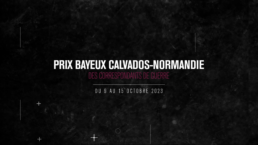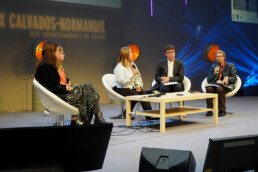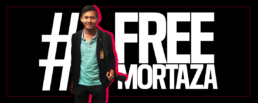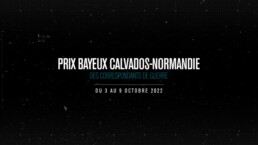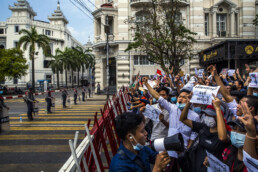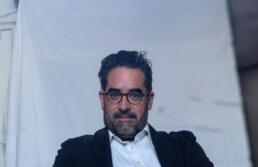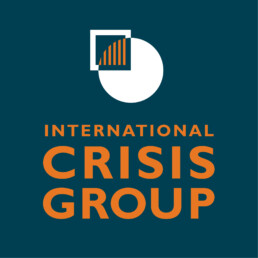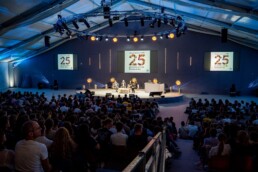Call for entries for Nikon portfolio readings
Come and present your work to leading image and photojournalism professionals at the portfolio readings organised as part of the partnership between Nikon and the Bayeux Award! This year, the readings will take place at Nikon Plaza on Monday 30 September 2024 from 1pm to 4pm and will be hosted by :
- Dimitri Beck - Director of Photography (Polka Magazine+Galerie+Factory)
- Olga Kravets - Writer, director and photographer (Mutin[R]y)
- Bénédicte Kurzen - Photojournalist (Noor)
- Véronique de Viguerie - Photojournalist (Getty Reportage / Verbatim Photo)
- Édouard Elias - Photoreporter (Galerie Polka)
- Adrien Vautier - Photojournalist
These lectures are aimed at amateurs or professionals who have already produced photo reports on subjects related to international news or in high-risk areas (areas of conflict, attacks on freedom and democracy, etc.).
To apply, send a covering letter and 20 photographs from a photo essay on a specific theme to nikonbayeux@gmail.com before 15 June 2024.
The selected photo essays will be exhibited twice: at Nikon Plaza from 1 October to 2 November, and at the Halle Ô Grains in Bayeux on Friday 11 October as part of the Rencontres Nikon during the 31st Bayeux Calvados-Normandy Award for War Correspondents. An evening presentation of the exhibition in the presence of the photographers will take place at Nikon Plaza on Monday 30 September from 5pm to 7pm.
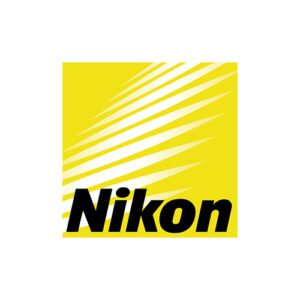
30th edition of the Bayeux Calvados-Normandy Award: results
More than forty war correspondents have gathered in Bayeux on October 13th and 14th to debate and award trophies in the following categories: photo, print, radio, television, grand format television, young reporter (print) and video image. Three honorary awards have been attributed: the Regional prize for students and trainees of Normandy (television), the Public’s Choice award (photo) and the Ouest-France – Jean Marin prize (print). Presided by Don McCullin, the international jury of the 30th edition of the Bayeux Calvados-Normandy Award for war correspondents has reached its verdict…
« It has been a great honor and a great experience to be here. We had two captivating days. Really stressfull on the first – especially on Saturday morning for me with the Photo Category – but captivating. Debates were quite interesting but difficult at the same time. It was not easy to decide the winners but every member of the jury was a generous and kind judge. The losers must not feel sad and the winners deserved what they got. »
Don McCullin
PHOTO TROPHY – INTERNATIONAL JURY
AWARDED BY NIKON
1st Prize
Siegfried MODOLA
Freelance
Au cœur de la rébellion birmane
MYANMAR
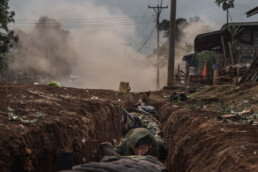
2nd Prize
Evgeniy MALOLETKA
ASSOCIATED PRESS
War in Ukraine
UKRAINE
3rd Prize
Alessio MAMO
THE GUARDIAN
Crimes de guerre contre les civils
UKRAINE
TELEVISION TROPHY – INTERNATIONAL JURY
AWARDED BY AMNESTY INTERNATIONAL
1st Prize
Nick PATON WALSH
Brice LAINÉ
Natalie GALLON
Etant DUPAIN
CNN
Gangs gain the upper hand in the war with Haitian police
HAITI
2nd Prize
Quentin SOMMERVILLE
Darren CONWAY
BBC NEWS
Sur l’Ukraine, ligne zéro
UKRAINE
3rd Prize
Luc LACROIX
Artur KOUN
Alexandra DALSBAEK
France 2
Les deux visages de Marioupol occupée
UKRAINE
PHOTO TROPHY – PUBLIC’S CHOICE AWARD
SPONSORED BY THE FRENCH DEVELOPMENT AGENCY (AFD)
1st Prize
Paula BRONSTEIN
GETTY IMAGES
The consequences of Ukraine war
UKRAINE
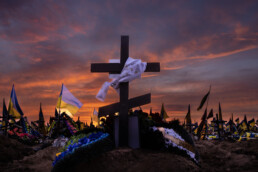
PRINT TROPHY – INTERNATIONAL JURY
AWARDED BY THE DEPARTMENT OF CALVADOS
1st Prize
Anthony LOYD
THE TIMES
L’otage oublié
IRAQ – SYRIA – MOROCCO
2nd Prize
Louis IMBERT
LE MONDE
Gaza – Cisjordanie
PALESTINE
3rd Prize
Florent VERGNES
XXI
Russafrique, les mercenaires de Poutine
CENTRAL AFRICAN REPUBLIC
RADIO TROPHY – INTERNATIONAL JURY
AWARDED BY THE D-DAY LANDING COMMITTEE
1st Prize
Maurine MERCIER
RTS – FRANCE INFO
La double peine d’une mère victime de viols à Boutcha
UKRAINE
2nd Prize
Quentin SOMMERVILLE
BBC NEWS
Ligne de front en Ukraine
UKRAINE
3rd Prize
Jean Samuel MENTOR
HAITINEWS2000.NET
Haïti : le corps des femmes, terrain de guerre des bandits
HAITI
YOUNG REPORTER TROPHY (PRINT) – INTERNATIONAL JURY
AWARDED BY CRÉDIT AGRICOLE NORMANDIE
1st Prize
Francis FARREL
THE KYIV INDEPENDENT
Dans l’enfer de Bakhmout : des mois d’une rare violence
UKRAINE
GRAND FORMAT TELEVISION TROPHY – INTERNATIONAL JURY
AWARDED BY INTERNATIONAL CRISIS GROUP
1st Prize
Edward KAPROV
Daniel FAINBERG
Eugene TITOV
Coproduction MAGNETO PRESSE and POLKA
for ARTE REPORTAGE
Ukraine : un photographe dans la guerre
UKRAINE
2nd Prize
Philomène REMY
Quentin BAULIER
Sofia KOCHMAR-TYMOSHENKO
Alexandra DALSBAEK
Simon TERRASSIER
BFM TV
Russia: The Stolen Children of Ukraine
UKRAINE – RUSSIA
VIDEO IMAGE TROPHY – INTERNATIONAL JURY
AWARDED BY ARTE, FRANCE 24, FRANCE TÉLÉVISIONS
1st Prize
Quentin SOMMERVILLE
Darren CONWAY
BBC NEWS
Sur l’Ukraine, ligne zéro
UKRAINE
PRINT TROPHY – OUEST-FRANCE – JEAN MARIN
1st Prize
Louis IMBERT
LE MONDE
Gaza – Cisjordanie
PALESTINE
TELEVISION TROPHY – REGIONAL PRIZE FOR STUDENTS AND TRAINEES OF NORMANDY
1st Prize
Nick PATON WALSH
Brice LAINÉ
Natalie GALLON
Etant DUPAIN
CNN
Gangs gain the upper hand in war with Haitian police
HAITI
Visual
The 2023 visual uses a photo from the 2022 winning report. This photograph taken by Evgeniy Maloletka was part of his report shot in March 2022 on the siege of Mariupol.
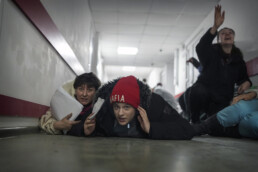
Caption: People lie on the floor of a hospital during a shelling by Russian forces in Mariupol, Friday, March 4, 2022.
Evgeniy Maloletka is a Ukrainian war photographer, journalist and filmmaker, who has been covering the war in Ukraine since 2014.
He has also covered the Euromaidan Revolution, the protests in Belarus, the Nagorno-Karabakh war and the COVID-19 pandemic in Ukraine.
His work was published in numerous prominent media: TIME, The New York Times, The Washington Post, Der Spiegel, Newsweek, The Independent, El Pais, The Guardian, The Telegraph and others.
In February and March 2022, during the Russian invasion of Ukraine, the Associated Press staff Mstyslav Chernov and Evgeniy Maloletka, stayed in Mariupol, which was encircled by the Russian troops, under siege, and extensively bombed, whereas the Russian Ministry of Foreign Affairs and the Defense Ministry claimed that Russia only targets military installations.
They were among the few journalists in Mariupol during that period, and their photographs were extensively used by Western media to cover the situation. On 11 March they were in a hospital taking photos when they were taken out of the city with the assistance of Ukrainian soldiers.
They managed to escape from Mariupol unharmed.
Evgeniy Maloletka writes: ”For me as a Ukrainian it is important to show the world what is really happening on the ground. We report what we see: the truth and facts, and portray the persistence and courage of ordinary Ukrainians.”
© Bayeux Award photo 2022 – Evgeniy Maloletka / Associated Press
Don McCullin, President of the jury of the 30th edition
For its 30th edition the Bayeux Calvados-Normandy Award for War Correspondents is preparing to welcome one of the greatest names in photojournalism: British photojournalist Don (Donald) McCullin has accepted the invitation and agreed to take on the role of President of the International jury. Renowned for his black and white photos, he intends to make full use of his visit to Bayeux to spend time exchanging with his colleagues on his vision of the profession and the future of the news media.
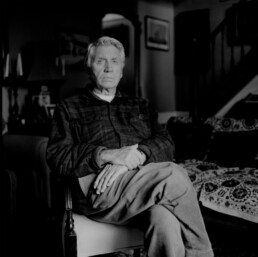
© Reg Stewart (courtesy Contact Press Images)
Since the publication in 1959 of his first photo in the British Observer, Don McCullin has been photographing war and the situation of the suffering, the destitute and the victims. The darkness of his images is equalled only by his humanity. “I’ve always pointed my camera in the direction of people who have no defence against their society, under-privileged people. I have to speak for the under-privileged.” Speak for them. Through his photos he would do this for more than half a century. Whether in deprived neighbourhoods of London or in the most far-flung war zones he would capture a situation, a gaze or an expression. “The story of a life can always be seen in the eyes of the victims.” He was able to feel, understand and reveal distress because he had experienced it himself. “When I started to photograph war, I already knew about violence. My life began in a part of London which was full of poverty, racism, violence and criminals. I had to leave school when I was 14, when my father died. I had no destiny and no education. Until I made up my mind I didn’t want to become a criminal and took another journey from that place where I grew up as a boy.” So it would be his own background and his own sensibility rather than his education that would make him such an exceptional photographer. “I’ve always had a very deep sense of feeling about humanity.”
“When I started to photograph war, I already knew about violence”
At the end of his military service in the Royal Air Force, during which he discovered both travel and photography, Don McCullin’s life took a major turn. Returning to London armed with a camera he immortalised his childhood friends, the Guv’nors gang, for posterity. The Observer newspaper published one of his photos to illustrate a crime story: this marked the start of his career. He quickly began to win major awards for his current affairs photography. In 1961 his report on the construction of the Berlin Wall received a British Press Award; in 1964 his coverage of the civil war in Cyprus was recognised by the distinguished World Press Photo award. In 1966 he signed an exclusive contract with The Sunday Times magazine, with which he would stay until 1984. During this period he covered every conflict of the time – Vietnam, Cambodia, Congo, Israel, Biafra, Northern Ireland, Bangladesh, Lebanon, Chad, El Salvador, Iran, Uganda…. He also documented the famines in Bihar (India) and Biafra (Nigeria). His forays to the hearts of the world’s trouble spots didn’t leave him unscathed: he received a punctured eardrum, bullet wounds and fractures as well as imprisonment, expulsions and threats. The photographer admits as much: “I paid in pain in many ways, and I’m lucky to be alive. But I couldn’t stop, I could have but there was something addictive about war. All those years I spent photographing war I thought I was doing something that was useful to our society, to explain what was going on in other places. What I was doing wasn’t personal: I was trying to show people the futility of war.”
“I was trying to show people the futility of war.”
Alongside his reports from overseas, Don McCullin continued to capture the deprivation ravaging his own country – deprived children in Bradford, down-and-outs in London, the working class of England’s industrial towns… “I’ve photographed a lot of poverty in England: there are 2 million people still living almost like dogs in this country. People don’t realise that.” His photographs of England in the 1970s were published in two books, Homecoming in 1979 and Hearts of Darkness in 1980. The latter, a retrospective of the first part of his career, would be the subject of an exhibition at the prestigious Victoria & Albert Museum in London in the year of its publication, and in New York the following year. It would be the start of a lengthy series of exhibitions around the world. The decade that followed saw another turning point in Don McCullin’s career: although he continued to cover war and its impacts on populations, his drive to tell human stories began to be complemented in his fifties by a passion for landscapes. It was both a passion and a form of therapy. “When you’ve spent so many years like me looking at war there’s no way you can ever chase away the images from your memory: there’s no treatment. Photographing landscapes helped me, I had to do something different. Instead of going to a psychiatrist I became my own psychiatrist by using my photographic knowledge. Half my memory now is war, and the other half is peace.” After immortalising all that was worst in the world, Don McCullin would now capture the beauty it has to offer. “I don’t want to be remembered just as a war photographer of dead bodies and war and pain because I’ve also photographed the most beautiful things: I photographed flowers, landscapes, ethnic minority people in jungles. I’ve been all over the world photographing all kinds of things that are not war.” All over the world, certainly, but above all close to home, in the English countryside of Somerset.
“I don’t want to be remembered just as a war photographer, because I’ve also photographed the most beautiful things”
Since he’s no longer physically able to “climb over the hedgerows and fields and gates and travel the world” Don McCullin continues to work on books. Following on from his celebrated autobiography Unreasonable Behaviour, published in 1990 (appearing in France under the title Risques et périls) and numerous other books, in June 2023 he is to publish a collection devoted to the Roman heritage in Turkey. An exhibition in Rome will follow in October. It will be a busy autumn for this prolific photographer, who will preside over the international jury for the 30th Bayeux Calvados-Normandy Award for War Correspondents on 13 and 14 October. He is looking forward to meeting up with many of his colleagues there. “I’ve always been very happy being around journalists and photographers. They’ve been my life and I’m always happy when I’m with them. It will be an opportunity for me to hear what they think about the coverage of today’s conflicts, the work of photojournalists in the digital age of social networks. I wonder a lot about the future of the media, and these exchanges will be fascinating.” As someone who has also lost many friends over the course of the years, and in particular French photographer Gilles Caron (who disappeared in Cambodia in 1970), the memorial ceremony held in Bayeux will be an important occasion. “We can’t forget all those who have died for this cause, people who have sacrificed their lives in journalism to bring the truth of our world to our news organisations. Young journalists have to be aware that only they can keep themselves alive, or keep journalism and the industry of journalism and the news media alive. I’m coming to Bayeux for many reasons, but above all I’d like to use my voice, my influence to say ‘We must keep our eyes open’.”
“Photography for me is not looking, it’s feeling. If you can’t feel what you’re looking at, then you’re never going to get others to feel anything when they look at your pictures”. (donmccullin.com)
1935 – Donald McCullin is born in London
1961 – British Press Award for his report on the building of the Berlin Wall
1964 – World Press Photo for his coverage of the civil war in Cyprus
1971 – Publication of his first photo essay The Destruction Business
1979 – Publication of Homecoming
1980 – Publication of the collection Hearts of Darkness
1992 and 1993 – Prix Erich-Salomon, Appearance of Photo Poche no 53
1993 – Became the first photojournalist to be awarded the C.B.E (Commander of the British Empire)
1995 – His archives are represented and distributed by Contact Press Images
2001 – Publication of Don McCullin, a major retrospective
2005 – Exhibition at the Bayeux Award
2006 – Cornell-Capa Prize (Cornell Capa Infinity Award) at the International Center of Photography (ICP), New York
2007 – Publication of In England
2007 – Honoured by the Royal Photographic Society : honorary Fellowship (FRPS) and Centenary Medal for his contribution to the art of photography
2009 – Publication of the 30th Reporters Without Borders album
2010 – Publication of Southern Frontiers, A Journey Across the Roman Empire on ruins from the Roman empire
2013 – Honorary Gold Visa from Figaro Magazine
2016 – Lucie Award for photojournalism
2017 – Made a Knight Bachelor by the Queen for services to photography. Prince Charles presided at the ceremony.
2019 – Extensive retrospective at Tate Britain, London.
2020 – ICP Lifetime Achievement Award
2023 – President of the Jury for the 30th Bayeux Calvados-Normandy Award for War Correspondents
An exceptional occasion for school children
For the 30th edition, the HCR - the United Nations Agency for refugees - and Ouest-France newspaper are offering an exceptional educational event for middle and high school students in Normandy: “the HCR-Ouest-France Encounters”.
Partners of the Bayeux award, the HCR and Ouest-France will be addressing school students and inviting them to meet refugees who will talk about their experiences of exile and the importance of international protection for those fleeing from war and persecution. In this age of instantaneous information, the HCR and Ouest-France aim to give young people a different understanding of the position of refugees in France and around the world.
#FREEMORTAZA
The Bayeux Award is working alongside Reporters Without Borders for the immediate release of journalist Mortaza Behboudi, who
has been unduly imprisoned in the Afghan capital since 7 January. Winner of the Bayeux Award in 2022 with Dorothée Ollieric and
Nicolas Auer, Mortaza Behboudi came on stage to talk about the situation in Afghanistan and especially about his work as a journalist
in the field.
The annual Reporters Without Borders report on abuses against journalists worldwide registered a record of 533 journalists in
detention in 2022.
29th edition of the Bayeux Calvados-Normandy Award: results
8 octobre 2022News,Non classé @en
More than forty war correspondents have gathered in Bayeux on October 7th and 8th to debate and award trophies in the following categories: photo, print, radio, television, grand format television, young reporter (photo) and video image. Three honorary awards have been attributed: the Regional prize for students and trainees of Normandy (television), the Public’s Choice award (photo) and the Ouest-France – Jean Marin prize (print). Presided by Thomas Dworzak, the international jury of the 29th edition of the Bayeux Calvados-Normandy Award for war correspondents has reached its verdict…
« Alongside my colleagues, I discovered works of indisputable excellence. The level was so high it was difficult to decide between the reports! The deliberations were intense, essential, very nourished. To hear the arguments of my peers, of whom I respect the work, will remain an unforgettable experience for me.«
Thomas Dworzak
PHOTO TROPHY – INTERNATIONAL JURY
AWARDED BY NIKON
1st Prize
Evgeniy MALOLETKA
ASSOCIATED PRESS
A Siege in Mariupol
UKRAINE
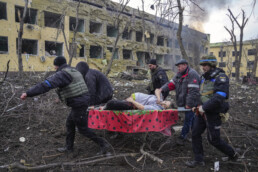
2nd Prize
Yasuyoshi CHIBA
AFP
Les rebelles reprennent la capitale du Tigré
MEKELE, ETHIOPIA
3rd Prize
Vadim GHIRDA
ASSOCIATED PRESS
War in Ukraine
UKRAINE
TELEVISION TROPHY – INTERNATIONAL JURY
AWARDED BY AMNESTY INTERNATIONAL
1st Prize
Théo MANEVAL and Pierre DEHOORNE
France 5 – C dans l’air
Viktor et le baiser de la guerre
UKRAINE
2nd Prize
Mstyslav CHERNOV
ASSOCIATED PRESS
Marioupol – La mort d’une ville ukrainienne
UKRAINE
3rd Prize
Jeremy BOWEN and Lee DURANT
BBC
Des cadavres sur la route du cauchemar
UKRAINE
PHOTO TROPHY – PUBLIC’S CHOICE AWARD
SPONSORED BY THE FRENCH DEVELOPMENT AGENCY (AFD)
1st Prize
Vadim GHIRDA
ASSOCIATED PRESS
War in Ukraine
UKRAINE
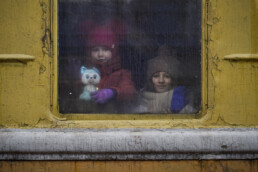
PRINT TROPHY – INTERNATIONAL JURY
AWARDED BY THE DEPARTMENT OF CALVADOS
1st Prize
Mariam OUEDRAOGO
EDITIONS SIDWAYA
Axe Dablo-Kaya : la route de l’enfer des femmes déplacées internes
BURKINA FASO
2nd Prize
Margaux BENN
LE FIGARO
En Ukraine, la rage de vivre pour vaincre l’horreur
UKRAINE
3rd Prize
Rachida EL AZZOUZI and Mortaza BEHBOUDI
MEDIAPART
À travers l’Afghanistan, six mois après le retour des talibans
AFGHANISTAN
RADIO TROPHY – INTERNATIONAL JURY
AWARDED BY THE D-DAY LANDING COMMITTEE
1st Prize
Maurine MERCIER
France INFO – RTS
Guerre en Ukraine : une mère et sa fille racontent deux semaines de viols et de terreur à Boutcha
UKRAINE
2nd Prize
Quentin SOMMERVILLE
BBC NEWS
La patrouille à pied
UKRAINE
3rd Prize
Jeremy BOWEN
BBC NEWS
Iryna Kostenko
UKRAINE
YOUNG REPORTER TROPHY (PHOTO) – INTERNATIONAL JURY
AWARDED BY CRÉDIT AGRICOLE NORMANDIE
1st Prize
Abdulmonam EASSA
Freelance for Le Monde, The New York Times, Getty Images
La rage pacifique ne meurt pas
SUDAN
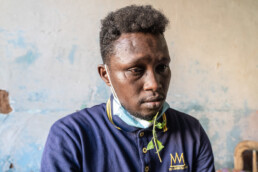
GRAND FORMAT TELEVISION TROPHY – INTERNATIONAL JURY
AWARDED BY INTERNATIONAL CRISIS GROUP
1st Prize
Philip COX
THE GUARDIAN
Le Spiderman du Soudan
SUDAN
2nd Prize
Ben C. SOLOMON
Adam DESIDERIO
VICE NEWS
Fall of Kandahar
AFGHANISTAN
VIDEO IMAGE TROPHY – INTERNATIONAL JURY
AWARDED BY ARTE, FRANCE 24, FRANCE TÉLÉVISIONS
1st Prize
Mstyslav CHERNOV
ASSOCIATED PRESS
Marioupol – La mort d’une ville ukrainienne
UKRAINE
PRINT TROPHY – OUEST-FRANCE – JEAN MARIN
1st Prize
Nicolas DELESALLE
PARIS MATCH
Ukraine : le convoi de la dernière chance
UKRAINE
TELEVISION TROPHY – REGIONAL PRIZE FOR STUDENTS AND TRAINEES OF NORMANDY
1st Prize
Dorothée OLLIERIC, Nicolas AUER and Mortaza BEHBOUDI
France 2
Les petites filles afghanes vendues pour survivre
AFGHANISTAN
Thomas Dworzak, Jury Chair for the 29th edition
31 mai 2022News,Non classé @en
Thomas Dworzak is an internationally acclaimed war photographer and a specialist in the Caucasus, who has been documenting the majority of world events since the 1990s. He has been a member of Magnum Photos since 2000 and was their president from 2017 to 2020. His work has been widely published, including by The New Yorker, Newsweek, U.S. News & World Report, Paris Match, The New York Times Magazine, Time… He won the World Press Photo award in 2001 for a report in Chechnya.
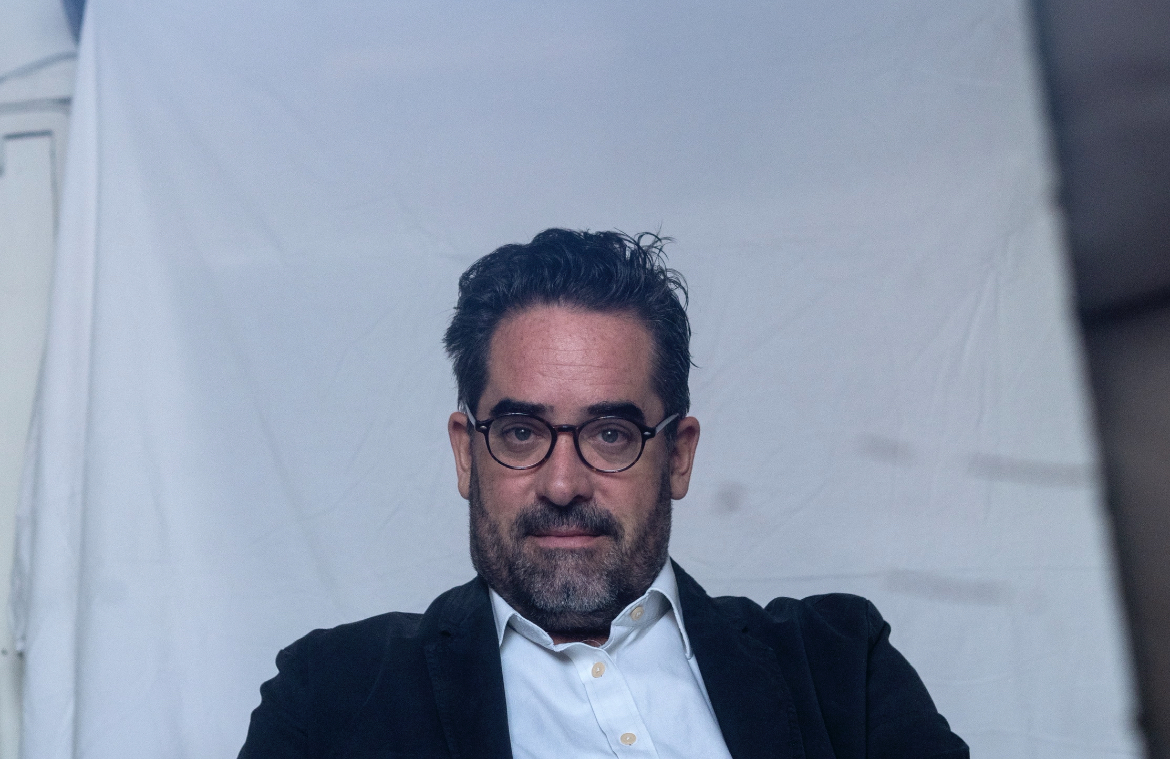 The self-taught photojournalist Thomas Dworzak (50) has spent the last thirty years travelling throughout the world, from Afghanistan to Iraq via the former Yugoslavia, Iran and the Caucasus, providing an unconventional take on the conflicts. He has been a member of the prestigious Magnum Agency since 2000 and has received many awards, notably from the World Press Photo in 2001 for his work in Chechnya.
The self-taught photojournalist Thomas Dworzak (50) has spent the last thirty years travelling throughout the world, from Afghanistan to Iraq via the former Yugoslavia, Iran and the Caucasus, providing an unconventional take on the conflicts. He has been a member of the prestigious Magnum Agency since 2000 and has received many awards, notably from the World Press Photo in 2001 for his work in Chechnya.
“I grew up in a peaceful part of Bavaria, in a provincial, very protected environment. I needed an extreme form of challenge. Photographing war is the ultimate in extreme.” Thomas Dworzak was born in Kötzting, in Germany, in 1972, and grew up in the small town of Cham, in a family of teachers. It was the height of the Cold War, and they were 7km from the iron curtain and the border with what was then Czechoslovakia.
“The wall had just come down but the East didn’t attract me. I went to Northern Ireland, Israel, Palestine. I had a vague idea of becoming a photographer. I had taken photographs but didn’t have any photographic culture or technique. It was a mixture of a wish to provoke, a desire to travel and an interest in stories, narratives, and especially the ones surrounding my maternal grandfather who had been killed in the war, and the deportation of my father’s family, which made me want to put the famous vest with pockets.”
With no network of contacts or funding, Thomas Dworzak tried to get to the former Yugoslavia, where the biggest conflict on European soil since the Second World War had just broken out. “I followed some German fascist volunteers to Croatia. I sent some small prints to the daily newspaper ’”Tageszeitung". They didn’t keep any of them.” His first break came in Prague, where he was taking language courses (he speaks French, English, Spanish and Russian). There he met the editor in chief of the only German newspaper in the city, through whom he obtained accreditation. A door-opener.
“Wostok, the smallest of the big agencies”
In 1992 he went to Moscow, and then settled in Tbilisi, in Georgia, from 1993 until 1998. “I was fascinated by the Caucasus, and spent most of my time between Grozny and Tbilisi. The Russian forces were merciless. The Chechens fought with pride. I discovered a people who were armed to the teeth, there were kalashnikovs everywhere, but they had an incredible sense of hospitality. ”He followed the conflicts in Chechnya but also in Karabakh and Abkhazia.
“In 1995, when I returned on a visit to Germany, I went to the French embassy. I asked for the yellow pages and sent applications to 40 agencies based in Paris.” Magnum politely replied that it is a cooperative with a very strict recruitment procedure. Wostok, "the smallest of the big agencies”, took him on. ”Jean-Claude Zullo and his wife, who was from Montenegro, took me under their wings. It was a small but highly respected agency. They brought me out of my isolation.” In 1999 he went to live in Paris. That same year he was called on by a friend who was a correspondent for The Guardian, and went to cover the crisis in Kosovo. “The technology boom was going on. I bought a colour scanner and a computer, and then I could be autonomous.” His work about a Serbian massacre was noticed by the U.S. News & World Report. ”I was becoming a pro. I was earning money. I was sending photos every day.”
2nd prize at Bayeux
A year later he returned to Chechnya after the Russian troops had left. “It was like day and night. Instead of being able to travel around freely as before, I had to have six bodyguards. Then an English journalist hired me as a Russian interpreter. By bringing her back to Chechnya as a fixer, I was able to take exclusive photos of the Chechen exodus. I took the best photos of my life while I was working as an interpreter.” His report “Leaving Grozny” was published by Newsweek, Paris Match, The New York Times and was awarded 2nd prize at Bayeux in 2000.
After the fall of Grozny be began work on a project looking at the impact of the war in Chechnya on the neighbouring North Caucasus. This work carried out between 1992 and 2002 was published in 2010 in the form of the book Kavkaz.
He also photographed events in Israel, the war in Macedonia, the refugee crisis in Pakistan, Baghdad under Saddam Hussein, and Iraqi Kurdistan.
Mainly based in New York since 2004, he photographed the political landscape in the USA and the consequences of the war in Iraq, to which he also devoted “M*A*S*H”, an astonishing composition combining the fictional film/series and the reality in Iraq, which was exhibited at Bayeux in 2007.
Dworzak joined the Magnum agency in 2000, becoming its president from 2017 to 2020. ”The agency wanted some new blood. I was surprised. I had thought it was only for very well established photographers, a sort of Holy Grail.”
His first book was made up of photos – that weren’t by him
After 11 September 2001 Thomas Dworzak spent several months in Afghanistan on an assignment for the New Yorker. He returned with his first book, “Taliban”. The project was surprising, provocative and subversive... The photojournalist’s project was based on portraits of members of the Taliban that he found in the back rooms of shops doing identity photos. They showed Taliban fighters against colourful, fantasy backgrounds, their eyes underlined with kohl… “First, the Taliban banned everyone from taking photos. Then they closed the photo studios, then they opened them again clandestinely, and in the end they had their photos taken. Except that no-one else was allowed to take them. So my first book is made up of photos that I didn’t take.”
Since than, he has been to Iran and Haiti. He has also produced reports on the revolutions taking place in republics of the former Soviet Union – Georgia, Kyrgyzstan and Ukraine. For his most recent project, “Feldpost” (2013-2018), he photographed the “memory” of the First World War in more than 80 countries. While covering the 2015 refugee crisis he devised “Europe – a photographic guide for refugees”, a book he produced himself and distributed free of charge to migrants.
His current project “War Games” is a long-term research project photographing all kinds of reconstructions, in the broadest sense of the term.
Thomas Dworzak is very “touched” to chair the jury at the Prix Bayeux, and says he is looking forward with impatience and curiosity to debating the way the Russian invasion of Ukraine has been covered by his colleagues. “I recently came across an old publication which had been used to illustrate an article called “Putin’s Wars”. In 2000. I feel as though I’ve made my career under the shadow of the leader. He set up an unhealthy relationship with the neighbouring countries. Somewhere between worship of a romantic idea of the Caucasus and fierce repression of any bid for freedom.”
Crisis Group sponsors the Grand format Television Prize
Crisis Group Partners with the Bayeux Award to support War CorrespondentsJournalists working in today’s conflict zones face increasing dangers in their efforts to provide the public with information. They are paying a heavy price. Not even halfway through 2022, seventeen journalists have already lost their lives in the line of duty, many of them in Ukraine.
Reflecting our deep admiration for what journalists do, and their bravery in doing it, the International Crisis Group is proud to become a partner of the Bayeux Calvados-Normandy Award for war correspondents and a sponsor of the Grand format Television Prize.
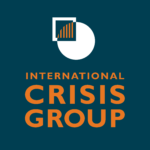 Crisis Group believes strongly in a free press, which plays a vital role in raising awareness about deadly conflicts, not only wars that dominate Western news coverage but also those that are too often neglected or forgotten, in Yemen, South Sudan or DR Congo. Journalists also explore the causes of conflict, and the motives of the combatants, often lighting the way for diplomats and others working to end wars and build peace. In this regard, the work of journalists frequently helps us at Crisis Group pursue our own conflict prevention mission.
Crisis Group believes strongly in a free press, which plays a vital role in raising awareness about deadly conflicts, not only wars that dominate Western news coverage but also those that are too often neglected or forgotten, in Yemen, South Sudan or DR Congo. Journalists also explore the causes of conflict, and the motives of the combatants, often lighting the way for diplomats and others working to end wars and build peace. In this regard, the work of journalists frequently helps us at Crisis Group pursue our own conflict prevention mission.
The Bayeux Award for war correspondents is a prestigious international annual prize for reporters covering conflicts or post-conflict situations. The Award recognises outstanding reporting about a given conflict and its impact on civilians as well as about the defence of freedom and democracy.
“I’m thrilled that Crisis Group is a partner of the Bayeux Calvados-Normandy Award”, said Comfort Ero, President and CEO of Crisis Group. “I have immense respect for the work of journalists in conflict zones, who have to navigate the dangerous front lines of conflicts and often battle disinformation”. “Video documentaries can be a powerful tool in shedding light on overlooked conflicts or complex situations as they bring a unique human perspective and can eventually contribute to helping solve them”, she added.
There are ten prizes of €7,000 in all categories of media: written press, radio, television and photography. Bayeux also honours a young reporter. An exhibition of the nominees’ work precedes the award ceremony. This year’s event will be held from 3 to 9 October 2022 in Bayeux, France.
We encourage members of the press to submit their reports or news stories by 7 June 2022. The reporting must have occurred between 1 June 2021 and 31 May 2022. For the Grand format Television Prize, the length of the report must be between 6 and 30 minutes.
Visual
The 2022 visual uses a photo from the 2021 winning report. This photograph taken by an anonymous Burmese photographer was part of his report shot between February and April 2021 during Myanmar's 'Spring Revolution'.
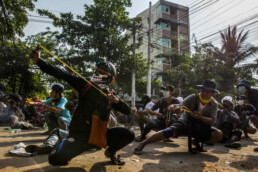
Caption: During a clash, protestors using homemade weapons such as slingshots and toy guns, defend as the security forces fired on the protest, in Tharketa township, Yangon, Myanmar, March 28, 2021. Soldiers and the police killed more than 126 people on the weekend of March 27 and March 28, according to the Assistance Association for Political Prisoners, a human rights group that is tracking the deaths. At least seven were children, including a 5-year-old boy, two 13-year-old boys and a 14-year-old girl.
The photographer grew up in Yangon and has documented important social issues in Myanmar including the military-run jade industry and the Rohingya crisis.
They have been a regular contributor to The New York Times covering Myanmar and other stories across Southeast Asia. Their work has also appeared in National Geographic Magazine, GEO, Stern, 6 MOIS, La Republica and The Wall Street Journal.
Since February 2021, when the Myanmar military staged a coup, the photographer has been covering the ongoing turmoil on assignment for The New York Times. They remain anonymous to protect their identity and avoid persecution from the authorities.
© Bayeux Award photo 2021 – Anonymous / The New York Times
Call for candidates
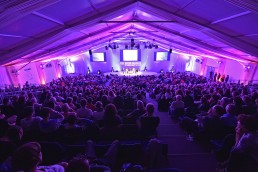
The Bayeux Calvados-Normandy award for war correspondents rewards reports about a conflict situation or its impact on civilians, or news stories involving the defence of freedom and democracy.
The report must have been made between 1 June 2021 and 31 May 2022. A €7,000 prize is awarded in each category.
The reports must be submitted to the following address by June 7th 2022: info@prixbayeux.org with a link to download the entry
The categories of media represented are: radio – photography – television (short and long formats) – written press and the young reporter prize (photo this year)
TEN PRIZES ARE AWARDED
Seven prizes awarded by the international jury
- Written Press Prize sponsored by the Calvados Department – €7,000
- Television Prize sponsored by Amnesty International- €7,000
- Radio Prize sponsored by the D-Day Landing Committee – €7,000
- Photo Prize sponsored by Nikon – €7,000
- Grand format Television Prize sponsored by International Crisis Group – €7,000
- Young reporter Prize sponsored by Crédit Agricole Normandie – €3,000
- Video image Prize sponsored by Arte, France 24 and France Télévisions – €3,000
Three special prizes
- The Ouest-France – Jean Marin Prize (written press) – €4,000
- The Public Prize (photo) sponsored by the Agence Française de Développement – €3,000
- The Normandy Region secondary School Students’ Prize (television) – €3,000
REGULATIONS
Reports published or broadcast only on digital media can apply in the same way as others (regardless of whether the report has been published in photo category).
• The Young Reporter’s Award: in 2022, the category is photo. Since there is a different category according to the years, the presented story must have been realized between 1 June 2020 and 31 May 2022.
• Written press category: the application must be made up of an article or a series of 1 to 5 articles on the same subject.
• Television category: the length of the report must be between 1 minute 30 seconds and 6 minutes. The report submitted must be identical to the broadcast piece.
• Grand format television category: the length of the report must be between 6 and 30 minutes. The report submitted must be identical to the broadcast piece.
• Radio category: the length of the report must be between 1 minute and 6 minutes. The report submitted must be identical to the broadcast piece.
• Photo category: the application comprises a report made up of 8 to 15 photos.
An exceptional occasion for school children
For the 29th edition, the HCR - the United Nations Agency for refugees - and Ouest-France newspaper are offering an exceptional educational event for middle and high school students in Normandy: “the HCR-Ouest-France Encounters”.
Partners of the Bayeux Award, the HCR and Ouest-France will be addressing school students and inviting them to meet refugees who will talk about their experiences of exile and the importance of international protection for those fleeing from war and persecution. In this age of instantaneous information, the HCR and Ouest-France aim to give young people a different understanding of the position of refugees in France and around the world.
The Nikon Encounters

Because of its history of more than a century and its values of commitment, it is in Nikon’s DNA to support photojournalism by being a partner of the Prix Bayeux.
Following the success of the first edition of the Nikon Encounters in 2021, the brand is repeating its initiative in 2022: on Friday, October 7, the public will be able to exchange with great names in photojournalism during exceptional Masterclass, testimonies and portfolio readings.
In addition, Nikon offers to pay for 12 participants for the training « REPORT IN DANGEROUS ZONES » of the Manoir created by France Médias Monde. In association with INA (the French national audiovisual archive) and with the support of Reporters without borders, the Manoir has already trained more than 360 reporters and information technicians and collaborates with many media. The training provided by the Manoir is now recognised as the reference standard in its field. While it is obvious that research and information-sharing are essential, the safety of journalists on assignment has to be both the primary concern and the starting point in the editorial process.
Because the journalist is the principal player in his or her own safety, the Manoir provides specific training and methodologies given by journalists to journalists, and brings in leading experts in the fields of health, emergency rescue and psychology.
By partnering with the Manoir, Nikon wants to support talented young photojournalists in the exercise of their profession by giving them the best possible training.
To apply, candidates must send their entry, including a CV, a motivation letter and one or more productions of a photo report produced in dangerous zones, to the address securite.academie@francemm.com before August 30, 2022.


